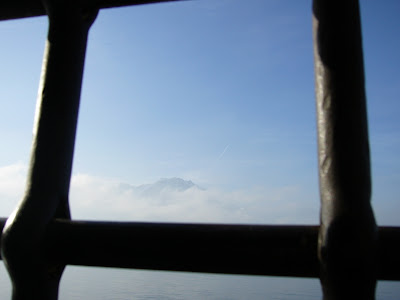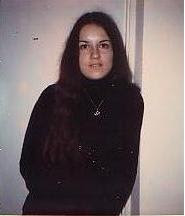At last I'm making good on a promise that goes back to December 07/January 08. At least the month of January isn't over just yet... Have lots of good excuses, work being one of them. I was suddenly swamped last week and much of the weekend. Good for my professional reputation, good for my budget, too... :)
But let's get down to "business": some visual impressions from one of four train, bus and hiking trips that my friend M. from England and I did late last December/early January. It was M.'s first visit to Switzerland -- she timed it perfectly!
Our first day out took us to Lausanne and on to Veytaux-Chillon, a little train station less than ten minutes' walk from the famous fortress in Lake Geneva.
 We wanted to visit a place that I had never been, either, and Chillon castle has been on my list since I was a little girl. Well, some of the best things in life take a long time to mature...
We wanted to visit a place that I had never been, either, and Chillon castle has been on my list since I was a little girl. Well, some of the best things in life take a long time to mature...This is what "le Château de Chillon" looks like from the train station:
 Across the lake you can just make out the Savoy Alps below rising cumulus clouds. I was hoping they would soon be burnt off by the December sun.
Across the lake you can just make out the Savoy Alps below rising cumulus clouds. I was hoping they would soon be burnt off by the December sun.Chillon rock has been inhabited by humans since the Bronze Age. It was also used by the Romans, of course. From the 11th to the 13th centuries, the first medieval enclosure wall (date unknown) set around the 2nd and 3rd courtyards was enlarged and partly rebuilt. Chillon was originally the property of the Bishops of Sion, and, from the early 12th century, held in fief by the Counts of Savoy. This was a period of great glory and the castle was enlarged to its current size. It contained military quarters, a chapel, storerooms and dungeons; it was the residence of the Constable of the Castle, and of the Count and his retinue. The Bernese (Swiss) seized the castle in 1536, using it as a depot, armoury and residence for their bailiffs until the Vaudois Revolution (1798). Chillon castle became the property of the newly-founded Canton of Vaud in 1803. Restoration work began in the late 19th century, greatly eased by documents found in the archives that permitted dating of a great number of the work done since the end of the 12th century (Castle Guide, passim).
The fortress guards a narrow ledge between the steep, rocky shore and the lake, a strategically perfect spot on the ancient road from Geneva to Italy across the Great St. Bernard Pass. Road tolls and taxes were, of course, collected on the vehicles and merchandise passing through.
 The castle on its rock lapped by the gentle waters of Lake Geneva. We chose a good day. I've seen the lake churned up like the sea on a stormy day.
The castle on its rock lapped by the gentle waters of Lake Geneva. We chose a good day. I've seen the lake churned up like the sea on a stormy day.  There's a natural moat between the mainland and the castle rock. It was widened in the 13th century. According to the free guide handed out at the entrance, it was filled in in the 19th century and cleared again in 1903.
There's a natural moat between the mainland and the castle rock. It was widened in the 13th century. According to the free guide handed out at the entrance, it was filled in in the 19th century and cleared again in 1903. 
 Not quite enough sun for the dial to tell us the time. Shame!
Not quite enough sun for the dial to tell us the time. Shame!The castle or fortress is a warren of walls, courtyards, steps, stairways, cellars and attic spaces.
 There's a system to this madness, as I discovered when reading one of the many instructive notices scattered all over the castle:
There's a system to this madness, as I discovered when reading one of the many instructive notices scattered all over the castle:"Chillon Castle - The keep, final refuge
"Situated approximately at the centre of the Chillon rock, the keep probably dates from the 11th century. In addition to its function as a refuge tower and symbol of power, it also served as an observation post for defence, as well as a temporary residence, warehouse, and during later periods, as a prison and powder magazine [what they want to say is "storage"]. For defence reasons, the door was high up and could only be reached by means of ladders or a drawbridge. …"
Here's one of those contraptions, very clever. It's not in the keep but an excellent example of a horizontal pivoting walkway, allowing people trapped inside to exit while keeping aggressors out, at least for a while. I was reminded of New York City fire escapes...:
 But on with the quotation from that notice:
But on with the quotation from that notice:"If the enemy succeeded in entering the castle, the main mass of the building and the defensive elements were arranged in a scattered way, in order to make the advance as long as possible before reaching the final refuge, the keep. This route ideally formed a spiral, turning to the right. Hence, the enemy always had his right side toward the defenders, which was the most vulnerable since unprotected by the shield. In Chillon this adextral principle is very well applied since even today the visitor has the keep always on his right hand side!"
See for yourself:

 Here's a great question for a pub quiz: "Why do spiral staircases always turn clockwise?"
Here's a great question for a pub quiz: "Why do spiral staircases always turn clockwise?" Above: View from the castle keep towards Montreux with its ugly hotel tower – a 20th-century fortress? By the train station and elsewhere along Lake Geneva, vines thrive right down at the water's edge. Much of the left shore of the lake is part of a UNESCO Heritage, the Lavaux wine growing region -- some of Switzerland's finest white wines are grown here.
Above: View from the castle keep towards Montreux with its ugly hotel tower – a 20th-century fortress? By the train station and elsewhere along Lake Geneva, vines thrive right down at the water's edge. Much of the left shore of the lake is part of a UNESCO Heritage, the Lavaux wine growing region -- some of Switzerland's finest white wines are grown here.Below: the Middle Ages meet the 20th century in this shot from Chillon Castle towards the Valais/top of Lake Geneva, with the motorway viaduct (the E27) set gracefully in the steep, rocky mountainside -- mist rising from the lake causes the milkiness in this photo:


 On a clearer day than this, you should be able to see the village of Gland and the city of Nyon, about 50 km down the lake.
On a clearer day than this, you should be able to see the village of Gland and the city of Nyon, about 50 km down the lake.On the far side of the rock there's a small exit straight down into the lake, perfect for quiet getaways.
 Beyond one of the barred windows the fog is rising and billowing -- just now you can see one of the peaks in the Savoy Alps, possibly Pic Boré or Les Hauts Forts (near Morzine/Avoriaz) - or Pointe d'Areux, Pointe Blanche? I've no idea really and Google Maps isn't helpful enough here. Your feedback will be most welcome!
Beyond one of the barred windows the fog is rising and billowing -- just now you can see one of the peaks in the Savoy Alps, possibly Pic Boré or Les Hauts Forts (near Morzine/Avoriaz) - or Pointe d'Areux, Pointe Blanche? I've no idea really and Google Maps isn't helpful enough here. Your feedback will be most welcome! A great way of displaying a fascinating collection of halberds. This is a space on the way up to the top of the keep.
A great way of displaying a fascinating collection of halberds. This is a space on the way up to the top of the keep.Last, but by no means least, a few shots of interior spaces:
 Magnificent oak door and colourful 13th century tapestries in the Grand Hall of the Count, now called the Hall of Justice.
Magnificent oak door and colourful 13th century tapestries in the Grand Hall of the Count, now called the Hall of Justice. Superb fireplace with the Savoyard coat of arms (or is it an early Swiss cross -- I'm not sure), beautiful black marble pillars. Modern folding chairs modelled on medieval originals. The tablecloths explain how, when and why banquets were held, what food was served, who sat where -- a great read.
Superb fireplace with the Savoyard coat of arms (or is it an early Swiss cross -- I'm not sure), beautiful black marble pillars. Modern folding chairs modelled on medieval originals. The tablecloths explain how, when and why banquets were held, what food was served, who sat where -- a great read. One of the many beautifully shuttered windows, some of them overlooking the third courtyard while others overlook Lake Geneva.
One of the many beautifully shuttered windows, some of them overlooking the third courtyard while others overlook Lake Geneva. Fabulously beautiful ceiling in what was once a withdrawing room and, according to the small guide, became a torture chamber in the 17th century. The artistry and craftsmanship are superb -- I wonder how long it took just to paint those little black whorls onto the lake-green paint covering the beams. And I'm sure those drum-shaped pegs serve a structural purpose. Wish my carpenter/joiner Grandfather were still around -- he'd have known, I'm sure.
Fabulously beautiful ceiling in what was once a withdrawing room and, according to the small guide, became a torture chamber in the 17th century. The artistry and craftsmanship are superb -- I wonder how long it took just to paint those little black whorls onto the lake-green paint covering the beams. And I'm sure those drum-shaped pegs serve a structural purpose. Wish my carpenter/joiner Grandfather were still around -- he'd have known, I'm sure.The red and white pattern on the walls is Savoyard.
 My only regret for that visit to Lake Geneva was that the sun didn't actually manage to burn off all the cloud and I wasn't able to show M. the glory of those peaks across the lake.
My only regret for that visit to Lake Geneva was that the sun didn't actually manage to burn off all the cloud and I wasn't able to show M. the glory of those peaks across the lake.Next post: some winter photos of Le Pays d'en Haut -- Montreux to Gstaad via Château-d'Oex (hot-air balloon paradise).






No comments:
Post a Comment